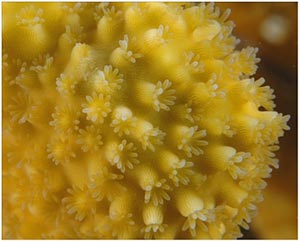 Corals are marine organisms from the class Anthozoa and typically live in colonies of many identical polyps-like individuals; each polyp is only a few millimeters in diameter. Over thousands of generations, the polyps lay down a skeleton that is characteristic of their species. Corals found in tropical oceans, in shallow and clear water, are getting the most of their nutrition from symbiotic unicellular algae that live in the stomach cells of the polyp. Cold-water corals do not have associated algae and are adapted to live in much deeper water, such as in the Atlantic, with the genus Lophelia surviving as deep as 3000 m. Corals represent rich underwater ecosystems, accommodating a big diversity of marine species.
Corals are marine organisms from the class Anthozoa and typically live in colonies of many identical polyps-like individuals; each polyp is only a few millimeters in diameter. Over thousands of generations, the polyps lay down a skeleton that is characteristic of their species. Corals found in tropical oceans, in shallow and clear water, are getting the most of their nutrition from symbiotic unicellular algae that live in the stomach cells of the polyp. Cold-water corals do not have associated algae and are adapted to live in much deeper water, such as in the Atlantic, with the genus Lophelia surviving as deep as 3000 m. Corals represent rich underwater ecosystems, accommodating a big diversity of marine species.




